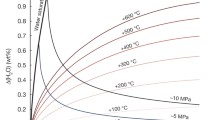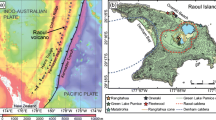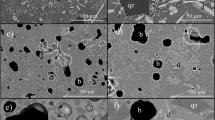Abstract
The ratio of the volume of vesicles (gas) to that of glass (liquid) in pumice clasts (V G /V L ) reflects the degassing and dynamic history experienced by a magma during an explosive eruption. V G /V L in pumices from a large number of Plinian eruption deposits is shown here to vary by two orders of magnitude, even between pumices at a given level in a deposit. These variations in V G /V L do not correlate with crystallinity or initial water content of the magmas or their eruptive intensities, despite large ranges in these variables. Gas volume ratios of pumices do, however, vary systematically with magma viscosity estimated at the point of fragmentation, and we infer that pumices do not quench at the level of fragmentation but undergo some post-fragmentary evolution. On the timescale of Plinian eruptions, pumices with viscosities <109 Pa s can expand after fragmentation, as long as their bubbles retain gas, at a rate inversely proportional to their viscosity. Once the bubbles connect to form a permeable network and lose their gas, expansion halts and pumices with viscosities <105 Pa s can collapse under the action of surface tension. Textural evidence from bubble sizes and shapes in pumices indicates that both expansion and collapse have taken place. The magnitudes of expansion and collapse, therefore, depend critically on the timing of bubble connectivity relative to the final moment of quenching. We propose that bubbles in different pumices become connected at different times throughout the time span between fragmentation and quenching. After accounting for these effects, we derive new information on the fragmentation process from two characteristics of pumices. The most important is a relatively constant minimum value of V G /V L of ∼1.78 (64 vol.% vesicularity) in all samples with viscosities >105 Pa s. This value is independent of magma composition and thus reflects a property of the eruptive mechanism. The other characteristic is that highly expanded pumices (>85 vol.% vesicularities) are common, which argues against overpressure in bubbles as a mechanism for fragmenting magma. We suggest that magma fragments when it reaches a vesicularity of ∼64 vol.%, but only if sheared sufficiently strongly. The intensity of shear varies as a function of velocity in the conduit, which is related to overpressure in the chamber, so that changes in overpressure with time are important in controlling the common progression from explosive to effusive activity at volcanoes.
Similar content being viewed by others
Author information
Authors and Affiliations
Rights and permissions
About this article
Cite this article
Gardner, J., Thomas, R., Jaupart, C. et al. Fragmentation of magma during Plinian volcanic eruptions. Bull Volcanol 58, 144–162 (1996). https://doi.org/10.1007/s004450050132
Received:
Accepted:
Published:
Issue Date:
DOI: https://doi.org/10.1007/s004450050132




